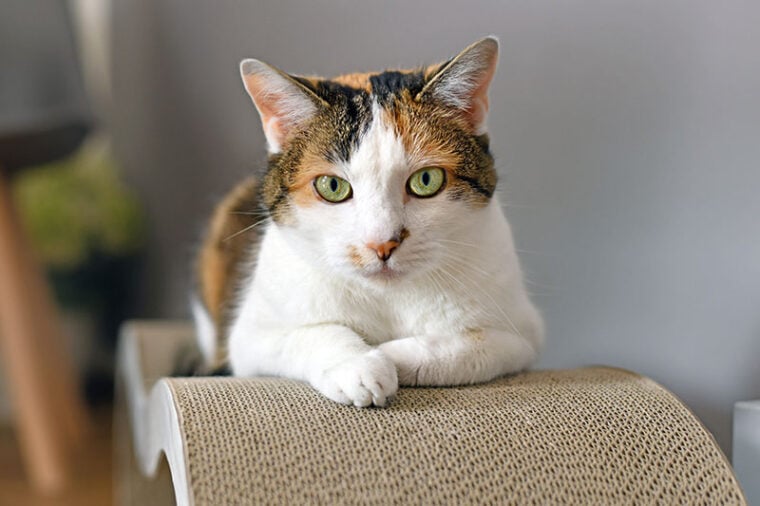
Click to Skip Ahead
Cat eyes are so gorgeous that people have mimicked the shape and style of a cat eye with makeup for thousands of years. But what happens when those beautiful eyes start to lose their normal appearance?
Iris atrophy is one eye condition over dozens that a cat can experience, but it’s rare. Your cat is much more likely to suffer from conjunctivitis or uveitis than iris atrophy. However, if your cat is the exception in this scenario, keep reading. This post covers everything about iris atrophy, from what it is to what you can expect as your cat ages. Let’s dive in.
What Is Iris Atrophy?
The iris is the beautiful, round, colored area surrounding the pupil. Muscles allow the iris to contract or expand, regulating the amount of incoming light through the pupil, the slit-shape opening in the middle of the iris. In simple terms, iris atrophy is the weakening of the iris muscles. When this occurs, the iris can’t function properly and the pupil can’t constrict, allowing more light to pass through to the retina than usual.
Cat eyes function in much of the same way as human eyes with a couple of differences, one of those being sensitivity to light. Cats have a special layer of tissue beneath the retina that reflects incoming light, the tapetum lucidum. This gives the eye a second chance to receive information, making cats about six times more sensitive to light than humans. This is important because, given the role of the iris, cats with iris atrophy can have more sensitivity to light than usual and may appear photophobic.

What Are the Signs of Iris Atrophy?
Signs your cat might have iris atrophy include:
What Are the Causes of Iris Atrophy?
Most of the time, iris atrophy is a natural part of the aging process. Like humans, cat eyes degrade slowly as they age. But other health concerns can cause iris atrophy as well, such as uvea inflammation and glaucoma.
1. Uvea Inflammation
The uvea is a larger part of the eye made of the iris, ciliary body, and choroid. When these parts of the eye become inflamed, the result is very serious and potentially blinding. Several reasons cause uveal inflammation, like infections, high blood pressure, toxins, autoimmune diseases, trauma, and more.
2. Glaucoma
Glaucoma is when the liquid inside of the eye (aqueous humor) doesn’t drain properly and builds up. When this occurs, the pressure within the eye increases, causing pain and, ultimately, blindness. Secondary glaucoma is more common and usually occurs in older cats.

How Is Iris Atrophy in Cats Diagnosed?
Vets need to be sure the iris abnormalities are, in fact, iris atrophy. Other eye conditions could be the cause, so a thorough eye exam of the eye, eyelids, surrounding tissue, and cranial nerve is necessary.
During the exam, your vet will use different tools to test your cat’s eye reflexes, light responses, and how well your pet sees in dim and bright lighting. Your vet may choose additional tests if your cat’s condition requires them.
How Do I Care for a Cat With Iris Atrophy?
When iris atrophy is part of the aging process, no treatment is required and it is considered a benign process. If iris atrophy is caused by an underlying problem, the treatment will go into whatever condition causes your kitty’s eye health problems. Unfortunately, iris atrophy is incurable and will most likely progress as your kitty ages, but thankfully, it’s not painful.
When it comes to pets and bad vision, the best way to help your pet is through little things like leaving furniture in place, making the litter box easily accessible, and administering medication.
The more you know about your cat’s condition, the better you can assess what your cat will need specifically.

Frequently Asked Questions (FAQs)
Is Iris Atrophy Painful?
Iris atrophy isn’t painful, although some eye problems that occasionally cause iris atrophy might be painful.
Will Iris Atrophy Cause Blindness?
Iris atrophy won’t cause blindness—just sensitivity to light.
How Can I Test My Cat’s Eyesight?
When a cat’s eyesight weakens, the signs are pretty obvious. You’ll notice your cat wandering, bumping into walls, missing jumps, and having trouble locating food, water, and litter boxes. Iris atrophy isn’t blindness, so your cat should see just fine besides being sensitive to light. The most obvious signs will be seen in your cat’s iris.
Is Iris Atrophy Curable?
Unfortunately, iris atrophy is incurable.
Conclusion
Seeing your cat’s vision weaken is difficult to grasp. Cats are so athletic, cuddly, and full of life. It’s a shame vision must vanish. The good news is that a cat can still live its best life even while their vision slowly fades. Animals understand that they must adapt to survive. And with you in the picture, your cat will do just fine with a little guidance.
Featured Image Credit: Firn, Shutterstock







